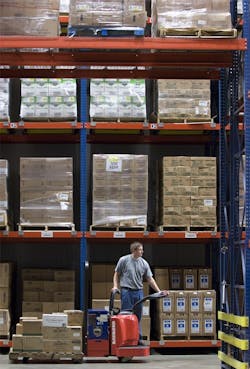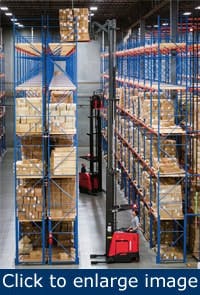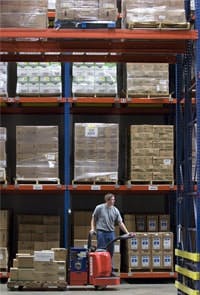Ongoing pressures to reduce costs can be overwhelming, especially considering the factors in a warehouse or distribution center that add expense. However, taking a close look at your lift truck fleet to ensure the right truck is being used for the right application can be a relatively easy way to reduce costs.
Three steps enable plant professionals to get a handle on how lift trucks are being used and whether they’re used for the applications for which they’re intended. These steps are:
- Observe the fleet in action
- Assess cost
- Consult with a lift truck professional
Observe your fleet
Begin your study by taking a close look at the functions lift trucks are performing. Lift trucks are designed with specific tasks in mind. This means there’s a logical truck choice for every application. Some lift trucks can perform multiple functions, but it’s typical to limit a truck to two tasks, such as horizontal transport and order picking.
For example, reach trucks are designed to lift or retrieve pallets from racks, whereas pallet trucks are designed to transport loaded pallets from one place to another, such as from docks to racks (Table 1).
| Truck Designed for: | Truck Trailer Loading and Unloading Pallets | Horizontal Travel in the Warehouse | Full Pallet Put Away and/or Removal from Rack | Case Picking and Order Picking |
| Sit-Down Counterbalanced or Stand-Up Counterbalanced Truck | X | X | ||
| Reach Truck | X | |||
| Turret Truck | X | |||
| Orderpicker | X | |||
| End Rider Pallet Truck | X | X | ||
| Center Rider Pallet Truck | X | X | ||
| Walkie Pallet Truck | X |
You might see reach trucks being used for horizontal transport, which could be done more cost-effectively by a pallet truck. If your reach trucks spend a lot of time in the dock area moving pallets or transporting products from one place to another, it might be possible to trade in some of your reach trucks for pallet trucks. The better lift truck dealers would be willing to arrange a trade-in plan. Walkie pallet trucks are more economical than reach trucks in terms of both purchase price and ongoing maintenance. Switching to a more economical transportation truck can quickly reduce lift truck costs and expenses over the life of the truck.
Pay attention to the way materials are picked and put away for storage. Follow pallet movement to see where they’re loaded and unloaded. Note whether materials are moving frequently or if they sit idle waiting for a lift truck to put them away. Such observations offer a better understanding of where lift trucks are most needed.
Measure the costs
[pullquote]Many managers of warehouses and distribution centers don’t analyze costs related to lift truck maintenance very rigorously. Calculating the totals of your maintenance service invoices can be a great way to understand exactly how much that lift truck is costing throughout its life. Divide the total maintenance invoice amounts by 12 to get a monthly average. Compare that number to the current lift truck lease payment. It might make sense to lease a newer lift truck that requires less maintenance. Plus, newer models offer advanced technologies, such as AC motor technology, that can aid productivity by extending battery life.
Maintenance cost calculations also can indicate whether the right trucks are being used. If you notice that counterbalanced truck tires are being purchased every month, this might indicate the trucks are being used for travel applications. A pallet truck would be better suited to horizontal transport and would reduce unnecessary spending on new counterbalanced truck tires.
Consult with experts
A lift truck dealer can be a valuable asset when determining whether a lift truck is being used correctly for a specific application. Dealers have significant experience gleaned from projects with other end users. They’ve seen a variety of operations, procedures and warehouse layouts. Their extensive knowledge of lift truck applications qualifies them to offer sound advice about truck usage.
Dealers provide an outsider’s view of your operations and can pull service records to examine your maintenance costs. This outside perspective might result in suggestions that aren’t immediately obvious to your in-house staff. Plus, dealers might see aspects that can be streamlined or adjusted to increase productivity, such as opportunities to use narrow aisles or double-deep racking.
Forcing one lift truck type into every process results in lost productivity and unnecessarily wear and tear, which can lead to frequent maintenance and downtime. Select the right truck for the job to optimize productivity, efficiency and, ultimately, cost. Ensuring the right trucks are being used in specific applications is easy as one, two, three: observe, measure and consult.
Susan Comfort is Class II narrow aisle truck product manager at The Raymond Corp., Greene, N.Y. Contact her at [email protected] and (607) 656-2311.


